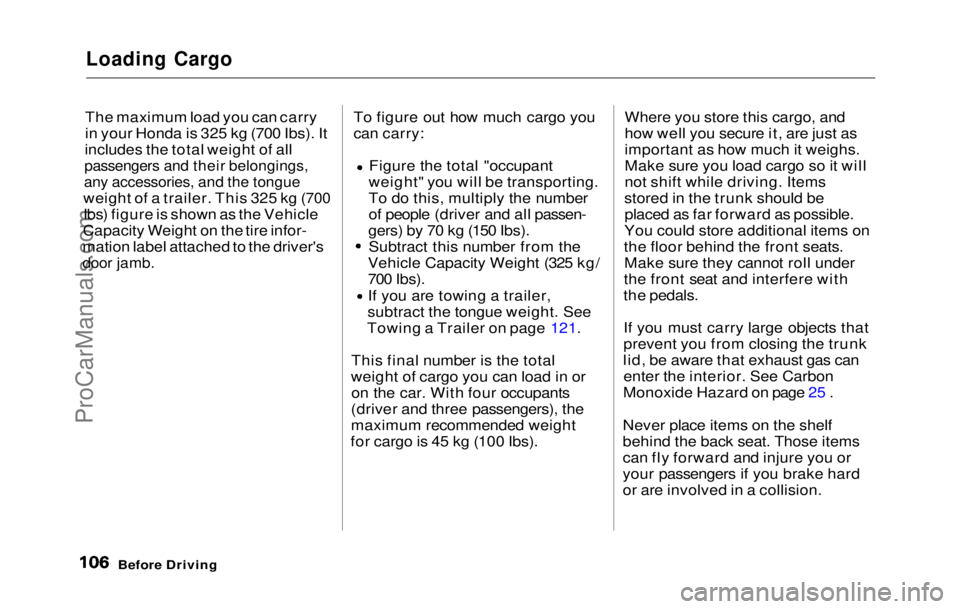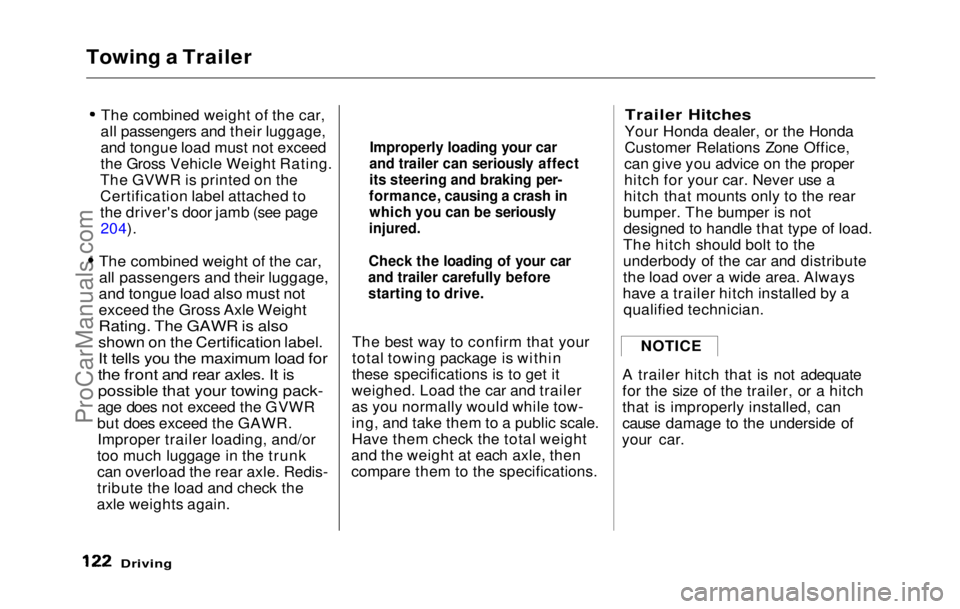Page 55 of 225
Folding Rear Seat
The back of the right rear seat
folds down, giving you direct
access to the trunk. The seat-back
can be released from inside the car
or inside the trunk.
To fold down the seat-back from
inside the car, insert the master
key in the lock on the rear shelf.
Turn the key clockwise and pull
down the top of the seat-back. To release the seat-back from
inside the trunk, pull the release
loop under the rear shelf.
To lock the seat-back upright, push if firmly against the rear shelf.
Make sure it is latched in place by
pulling on the top of the seat. Make sure all items in the trunk, or
items extending through the opening into the back seat, are tied
down. Loose items can fly forward
and cause injury if you have to
brake hard. See Loading Cargo
on page 106.
Never driv e
with the seat-back
folded down and the trunk lid open.
See Carbon Monoxide Hazard
on page 25.
Instruments and Controls
MASTER KEY
RELEASE LOOPProCarManuals.comMain Menu Table of Contents s t
Page 105 of 225

Loading Cargo
The maximum load you can carry
in your Honda is 325 kg (700 Ibs). It
includes the total weight of all
passengers and their belongings,
any accessories, and the tongue
weight of a trailer. This 325 kg (700
Ibs) figure
is shown as the Vehicle
Capacity Weight on the tire infor-
mation label attached to the driver's
door jamb.
To figure out how much cargo you
can carry:
Figure the total "occupant
weight" you will be transporting.
To do this, multiply the number
of people (driver and all passen-
gers) by 70 kg (150 Ibs). Subtract this number from the
Vehicle Capacity Weight (325 kg/
700 Ibs).
If you are towing a trailer,
subtract the tongue weight. See
Towing a Trailer on page 121.
This final number is the total
weight of cargo you can load in or on the car. With four occupants
(driver and three passengers), the
maximum recommended weight
for cargo is 45 kg (100 Ibs). Where you store this cargo, and
how well you secure it, are just as
important as how much it weighs.
Make sure you load cargo so it will
not shift while driving. Items
stored in the trunk should be placed as far forward as possible.
You could store additional items on
the floor behind the front seats. Make sure they cannot roll under
the front seat and interfere with
the pedals.
If you must carry large objects that
prevent you from closing the trunk
lid, be aware that exhaust gas can enter the interior. See Carbon
Monoxide Hazard on page 25 .
Never place items on the shelf
behind the back seat. Those items
can fly forward and injure you or
your passengers if you brake hard
or are involved in a collision.
Before DrivingProCarManuals.comMain Menu Table of Contents s t
Page 107 of 225
Preparing to Drive
You should do the following checks and adjustments every day before
you drive your car.
1. Make sure all windows, mirrors, and outside lights are clean and
unobstructed. Remove frost,
snow, or ice.
2. Check that the hood and trunk are fully closed.
3. Check that any items you may be carrying with you inside are
stored properly or fastened down
securely. 4. Check the adjustment of the seat
(see page 51 ).
5. Check the adjustment of the
inside and outside mirrors (see
page 59 ).
6. Chec k
the adjustment of the
steering wheel (see page 43 ).
7. Make sure the doors are securely
closed and locked.
8. Fasten your seat belt. Check that your passengers have fastened
their seat belts (see page 7 ). 9. Turn the ignition ON (II). Check
the indicator lights in the instru-
ment panel.
10.Start th
e
engine.
11.Check the gauges and indicator
lights in the instrument panel
(see page 31 ).
Driving
ProCarManuals.comMain Menu Table of Contents s t
Page 121 of 225

Towing a Trailer
The combined weight of the car,
all passengers and their luggage,
and tongue load must not exceed
the Gross Vehicle Weight Rating.
The GVWR is printed on the
Certification label attached to
the driver's door jamb (see page 204).
The combined weight of the car,
all passengers and their luggage,
and tongue load also must not
exceed the Gross Axle Weight
Rating. The GAWR is
also
shown on the Certification label.
It tell
s
you the maximum load for
the front and rear axles. It is
possible that your towing pack-
age does not exceed the GVWR
but does exceed the GAWR. Improper trailer loading, and/or
too much luggage in the trunk
can overload the rear axle. Redis-
tribute the load and check the
axle weights again. The best way to confirm that your
total towing package is within
these specifications is to get it
weighed. Load the car and trailer
as you normally would while tow-
ing, and take them to a public scale.
Have them check the total weight
and the weight at each axle, then
compare them to the specifications.
Trailer Hitches
Your Honda dealer, or the Honda
Customer Relations Zone Office,
can give you advice on the proper
hitch for your car. Never use a
hitch that mounts only to the rear
bumper. The bumper is not
designed to handle that type of load.
The hitch should bolt to the
underbody of the car and distribute
the load over a wide area. Always
have a trailer hitch installed by a qualified technician.
A trailer hitch that is not adequate
for the size of the trailer, or a hitch
that is improperly installed, can
cause damage to the underside of
your car.
Driving
Improperly loading your car
and trailer can seriously affect
its steering and braking per-
formance, causing a crash in which you can be seriously
injured.
Check the loading of your car
and trailer carefully before
starting to drive.
NOTICEProCarManuals.comMain Menu Table of Contents s t
Page 167 of 225
Lights
Replacing Rear Bulbs
1. Open the trunk and the taillight
assembly cover.
2. Use
a phillips head screwdriver
to remove the two screws from
the bulb holder. Remove the
holder from the taillight assem-
bly.
3. Try the tail/stoplights, rear turn
signals and back-up lights to
verify which bulb needs replac- ing. Remove that bulb from the
socket by pushing it in slightly
and turning it counterclockwise.
4. Instal l
the new bulb in the socket.
Test it to make sure it works.
5. Reinstal
l
the bulb holder assem-
bly. Install the two screws and
tighten them securely.
Maintenance
COVERProCarManuals.comMain Menu Table of Contents s t
Page 169 of 225
Lights
Replacing a Rear License
Bulb
1. Remove the two screws and remove the license light assem-
bly.
2. Remove the lens from the rubber
seal and the metal
cover.
3. Pull the bulb straight out of its
socket. Push the new bulb in
until it bottoms in
the socket.4. Turn on the parking lights and
check that the new bulb is
working.
5. Reinstall the cover and the lens.
Put the license light assembly in
place. Reinstall the two screws
and tighten them securely.
Replacing
Interior and Trunk
Light Bulbs
1. Remove the lens by carefully
prying on the edge of the lens in
the middle with a fingernail file
or a small flat-tip screwdriver.
Do not pry on the edge of the
housing around the lens.
CONTINUED
Maintenance
INTERIOR
LIGH
TProCarManuals.comMain Menu Table of Contents s t
Page 170 of 225
Lights
2. Remove the bulb by pulling it straight out of its metal tabs.
3. Push the new bulb into the metal tabs. Snap the lens back in place.
Maintenance
TRUNK LIGHTProCarManuals.comMain Menu Table of Contents s t
Page 181 of 225

Changing a Flat Tire
If you
have a flat tire while driving,
stop in a safe place to change it.
Stopping in traffic or on the shoul-
der of a busy road is dangerous.
Drive slowly along the shoulder
until you get to an exit or an area to stop that is far away from the traf-
fic lanes.
1. Park the car on firm, level ground away from traffic. Turnon the hazard warning lights and
turn the ignition to LOCK (0). 2. Put the transmission in Park
(automatic) or Reverse (5-speed).
Set the parking brake.
3. Open the trunk. Raise the trunk floor by lifting up on the back
edge.
4. Take the tool kit out of the trunk. 5. Unscrew the wing bolt and take
the spare tire out of the trunk.
Taking Care of the Unexpected
CONTINUED
The car can easily roll off the
jack, seriously injuring anyone
underneath.
Follow the directions for chang-
ing a tire exactly, and never
get under the car when it is
supported only by the jack.
TRUNK FLOOR
JACK
SPARE TIRE
TOOL KITProCarManuals.comMain Menu Table of Contents s t